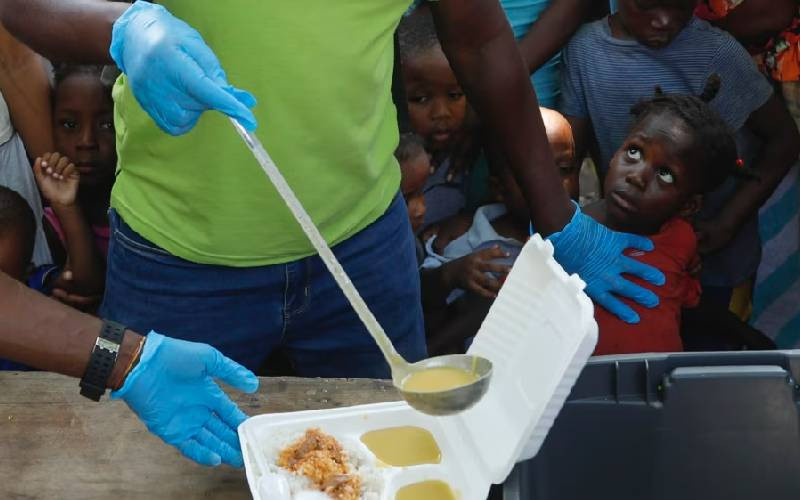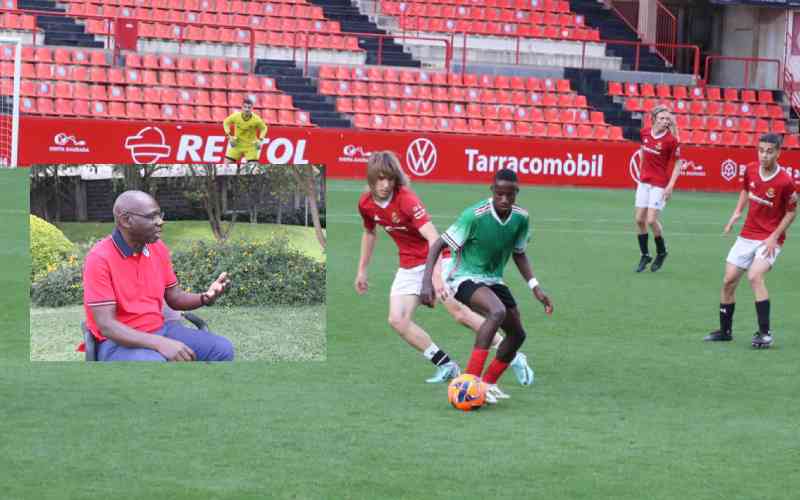 |
|
The late Kenneth Kimani who was allegedly shot dead by Police Constable, Titus Masila ‘Katitu’ [PHOTO: COURTESY/STANDARD] |
By NYAMBEGA GISESA
If you ask the youth hanging around the Githurai 45 roundabout in Kasarani, Nairobi, Police Constable Titus Masila had murder on his mind on April 14.
They say the officer – attached to the Kasarani Police Station – walked up to them dressed in civilian clothing with a gun strapped to the side of his hip. Many residents know Masila well as ‘Katitu’, after a famous Kamba music group. They also know him as ‘King’ei’, the gangster, because of his alleged reputation for violence.
Trudging through the morning rain, the officer allegedly hurled an insult at a handcart pusher and scattered terrified street boys without a glance. His target was a group of youth at a shop near the stage who run a business of charging mobile phones.
“Tafuta kitabu ya kuchanga pesa ya mazishi (Start looking for ways of raising funds for a funeral),” ‘Katitu’ allegedly told them. He did not say whose funeral it was to be, but the men knew what to expect. They say it is not uncommon for ‘Katitu’ to make such threats.
The Githurai 45 stage is rife with petty criminals. The Motorists Association of Kenya lists it as one of the most notorious for phone snatching, alongside Outer Ring Road, Kariobangi roundabout and the Country Bus Station (‘Machakos Airport’). Mob justice is common and policing can be rough and ready.
“If ‘Katitu’ tells you that you have two weeks to live, prepare to die,” says Njoroge, a resident who describes himself as a “reformed criminal”. Terrified at the thought they may be in Masila’s sights, the youths dispersed from the stage.
Kimani met his death
A kilometre away, one of their friends, Kenneth Kimani (alias Marley or Modo) was preparing to leave home. The 26-year-old was well known in Githurai Kimbo for his ties to the Mathare Youth Sports Association (MYSA). In his time, he had done duty as a top Mathare Youth and Mathare United footballer. He may have been headed to the bus stage, but his mother insists he was going to the nearby St Augustine Catholic Church for the Sunday morning Mass.
“I stopped him and asked him to look after my five-year-old granddaughter Stacey (whose mother, Stella, lives in Norway),” his mother, Purity Wanjiku, recalls.
The child was unwell and could not be left home alone. Kimani, who made his living as a footballer and chicken farmer, obliged. Throughout the morning, he remained with his sick niece at home, about 400 metres from the Githurai Kimbo Police Station. After 4pm, Kimani left home to join friends and watch an English Premier League football match between Chelsea and Manchester City. He was dressed in blue jeans and a striped blue T-shirt. He and a friend (name withheld) walked to the Githurai Bus Stop planning to catch the match at a nearby bar.
It was not to be. By 4.30pm, he was dead. Accounts of what happened that Sunday afternoon differ. Police claim an unnamed woman was mugged at the bus stop by a gang of five and robbed of a mobile phone. Her screams allegedly attracted PC Masila who allegedly shot at them, killing Kimani and injuring scores. They do not explain how the five ‘muggers’ escaped from the crowded area without being lynched.
There have been at least ten mob justice incidents in Nairobi in the last week alone, targeting muggers and suspected robbers. According to witnesses, including Kimani’s friend (who has now gone into hiding), an argument broke out when the footballer and Masila met at the bus stop. The officer allegedly accused the footballer of taking part in various crimes. The two grappled with each other for a moment, before Masila shoved Kimani to the ground at which point the unarmed MYSA player began pleading for his life. Unmoved, Masila allegedly drew his pistol and shot him three times in the face. The first bullet entered through the right hand side of Kimani’s forehead. It did not exit. The second went in below the mouth. This one exited just below the left ear. The third bullet entered through the right cheek and went out the back of Kimani’s neck.
Autopsy report
Stay informed. Subscribe to our newsletter
An autopsy report by Chief Government Pathologist Johansen Oduor dated four days later had findings that point to a clear intent to kill. They also contradict police claims that Kimani was killed from a distance while fleeing.
“Blackening around the entry wound suggests this was a gunshot at close range,” Dr Oduor comments. “The injuries suggest the firearm used was of low velocity.”
The fact Masila aimed for the head, which is easy to miss even for a marksman, and shot thrice, suggests he did not want Kimani to survive. Dr Oduor also noted “bruises on the right side of the face and on the forehead” which are consistent with eyewitness accounts of a struggle before the shooting. Concluding with certainty that Kimani died from a head injury due to “a gunshot at close range from a low velocity firearm”, the pathologist recovered a used bullet from his brain and handed it to the investigating officer, a Police Constable Mbiko, for ballistic examination. Police would not confirm whether the “low-velocity firearm” Masila used in the killing was a Government-issued service weapon. Kasarani OCPD Augustine Thumbi also refused to disclose the name of the investigating officer or release details on how his review of the shooting was going.
In the crime-prone Githurai 45 area, police shootings are rarely news. Residents tired of rampant crime have a love-hate relationship with trigger-happy policemen. They turn a blind eye when known criminals are gunned down but are angered when people they see as innocent are targeted. Kimani’s killing is one such alleged outrage.
A march to protest the killing was held by locals and human rights activists last Saturday, which would have been Kimani’s 27th birthday.
“That was cold-blooded murder,” says Odhiambo Oyoko, who runs an NGO called the Rights Promotion and Protection Centre. “(Kimani) was shot at point blank range while pleading for his life by an officer against whom (similar) complaints have been raised.”
Witnesses say immediately after the killing, uniformed officers confiscated phones from anyone photographing the scene. Journalists who arrived at the scene were told the slain man was in a gang of six armed with crude weapons that attacked a woman at the crowded bus stop and robbed her of a mobile phone.
We sought a reaction from PC Masila about the crime, the shooting and the investigation.
“You are not the complainant,” he responded, refusing to discuss the matter. Minutes later he called back and referred us to his superiors.
Nairobi police boss Benjamin Githinji said officers on patrol ordered Kimani to stop and surrender but he defied the order and was, therefore, shot dead. Githinji claimed Kimani’s accomplices escaped with gunshot wounds. When we asked the Kasarani OCPD about the killing recently, the story had changed: “He was in a gang of six who had just robbed commuters in a matatu.”
We visited the nearby Githurai Kimbo and Kasarani Police stations to seek out the details of the alleged crimes. There was no record of an attempted robbery on a matatu in both station’s Occurrence Books on the day of the killing. Neither was there any record of a complainant who had lost a mobile phone to muggers near the roundabout.
Police produced an envelope with a phone they say belongs to the mugging victim. The OCPD says the victim recorded a statement, but refused to share other details. He says two more witnesses are expected to record statements. More than four weeks after a killing in broad daylight, the incident remains shrouded in mystery.
The writer is the Media Council of Kenya’s Journalist of the Year 2013.
SEE ALSO: Githurai police hunt down three brothers.
UPDATE: Kenneth Kimani's brother Oscar Mwangi, who was in hiding fearing he, too, would be killed, was arrested on Friday in connection with the alleged theft of a mobile phone on May 1 this year. He is to be arraigned in court soon.
 The Standard Group Plc is a
multi-media organization with investments in media platforms spanning newspaper
print operations, television, radio broadcasting, digital and online services. The
Standard Group is recognized as a leading multi-media house in Kenya with a key
influence in matters of national and international interest.
The Standard Group Plc is a
multi-media organization with investments in media platforms spanning newspaper
print operations, television, radio broadcasting, digital and online services. The
Standard Group is recognized as a leading multi-media house in Kenya with a key
influence in matters of national and international interest.
 The Standard Group Plc is a
multi-media organization with investments in media platforms spanning newspaper
print operations, television, radio broadcasting, digital and online services. The
Standard Group is recognized as a leading multi-media house in Kenya with a key
influence in matters of national and international interest.
The Standard Group Plc is a
multi-media organization with investments in media platforms spanning newspaper
print operations, television, radio broadcasting, digital and online services. The
Standard Group is recognized as a leading multi-media house in Kenya with a key
influence in matters of national and international interest.










